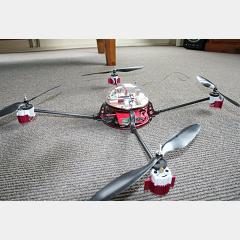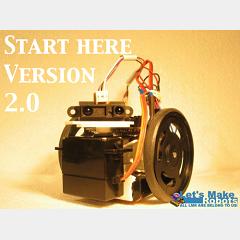Categories
- animatronics (12)
- apple (11)
- arduino (179)
- art (41)
- articles (121)
- artificial intelligence (11)
- automation (421)
- avr (205)
- bitcoin (3)
- breadboard (9)
- cameras (57)
- cars (26)
- cell phones (28)
- clothing mods (21)
- console mods (26)
- dangerous (94)
- desktop mods (24)
- embedded (5)
- flying things (54)
- fpga (22)
- gaming creations (108)
- interface (225)
- internet (17)
- laptop mods (6)
- lasers (22)
- linux (7)
- magnetic (3)
- medical (12)
- microcontrollers (51)
- misc projects (152)
- msp (12)
- music (124)
- pic (90)
- projects (23)
- pyroedu (76)
- raspberry pi (26)
- robots (312)
- security (36)
- sensors (307)
- software (200)
- solar (19)
- stamp (9)
- tools (149)
- tutorials (98)
- Uncategorized (45)
- usb (44)
- wireless (256)
Sponsors


Posted June 4, 2011 by Chris
Flying UAVs seem to be the ultimate challenge for robotics. Stabilizing the flyer is very difficult since you need to combine multiple sensors’ data into control loops. This article shows a successful build of a quadrotor and lists all parts used. A PID control loop is used for movement stability.

Posted June 1, 2011 by Chris
Solar powered robotics can be difficult to design, however this article gives a great example of how to make it work. The smiley solar powered robot uses differential drive motors with an analog brain to find its way. The article has the schematic and board layout available for download and describes how the robot works. Smile and build your own!

Posted May 27, 2011 by Chris
Making your first robot should be a moment you remember as you progress in the electronics and robotics field. Whether it is a line follower or a wall dodger, it brings you to the first step into a larger world. Today’s article gives you a great starting point for how to build your first robot. Similar to my line follower, except with more digital circuity.

Posted May 23, 2011 by Chris
Bipedal movement in robots is pretty rare because of the inherit difficulty of balance. IMU technology has slowly been advancing enough to bring us more humanoid type robots. The HWM is a fun look at what can be done with a little ingenuity and off-the-shelf parts. The article has great documentation for how this robot was built and a few action videos.

Posted May 17, 2011 by Chris
Here is a bit of an older design for a mobile robot using the OOPic MCU. It uses a few sensors and a servo gripper to go around looking for the right color of block to pick up. The article describes in depth the hardware and software design of the robot so that you can duplicate any part of the OB2 robot.

Posted May 9, 2011 by Chris
Here is a pretty sweet little robot that is a great resource for anyone looking to build their own mobile robotics platform. The article and google project is a documentation of a robot that combines together a mobile platform with various sensors for navigation and external sensory.

Posted May 4, 2011 by Chris
Quadcopters have been increasing in popularity in the robotics world because of their stability and ease of design. This project shows you how to make a remote control flying PCB. The motors are attached directly to the PCB! Since this project was made in 2000, it should be that much easier to make your own in 2011!

Posted May 3, 2011 by Chris
Here’s a small robot that uses a few servos to make it walk. At its heart is an AVR microcontroller and the rest of it is just make-shift parts. The article explains what parts were used and how everything fits together, but is a little light on details. Check out the action vid of the Little Brother walking!

Posted April 26, 2011 by Chris
Mixing a little creativity with robotic fun brings us the second yellow drum machine robot. It uses a few sensors to find something that it can use as a drum and then goes to town. The article has all the details of how to build your own.

Posted April 24, 2011 by Chris
This robotic project is an attempt to build an open source project with everyday products. The main sensor feedback comes from an Xbox Kinect, with a laptop for processing with the entire assembly ontop of a roomba-like device, making the system mobile. The project website is very transparent about how everything is being done, so no need to hunt for the details.






